Stalin used architecture as a political and ideological tool, constructing the Seven Sisters skyscrapers in Moscow to reflect the modernity, ambition and triumph of Soviet Russia. For years the tallest buildings in Europe, these seven commanding skyscrapers are significant monuments of architecture and urban planning which draw the eye from all over Moscow.
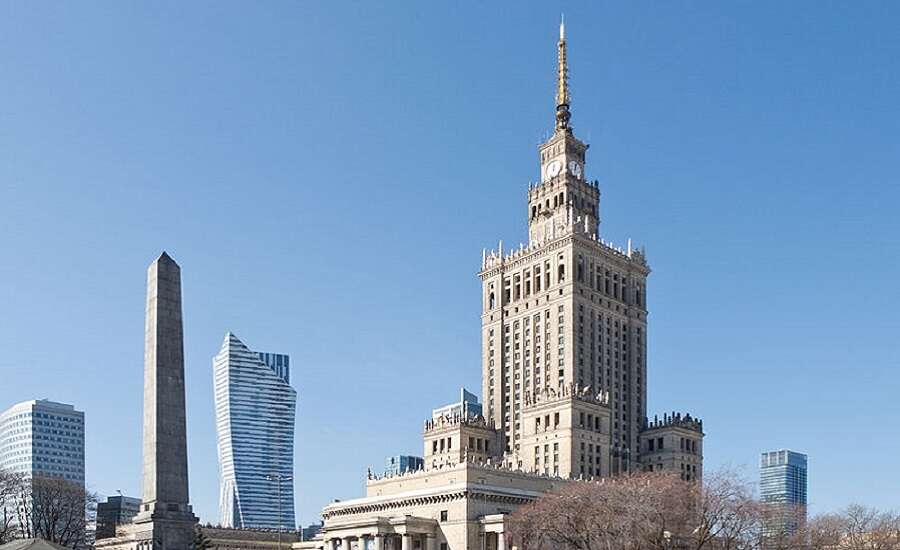
Photo by Carlos Delgado on Wikipedia
Stalin commissioned the Seven Sisters in Moscow to demonstrate the triumph and regeneration of the USSR after the devastation of the Second World War, and rival the high-rises of capitalist cities. Their foundations were laid on the 800th anniversary of Moscow in September 1947.
Eight buildings were planned on the city’s main intersections and in the bends of the Moskva River. The leading architects of the era were entrusted with each project, and received Stalin Prizes in 1949 for their plans. The tallest and most central skyscraper was to be the Zaryadye Administrative Building next to the Kremlin, but construction was halted after the death of Stalin (thankfully, as this huge building would have spoilt the architectural ensemble of the Kremlin and Red Square).
Did you know? Today, Park Zaryadye lies on the site where the Zaryadye Administrative Building would have stood.
Two of Stalin’s Seven Sisters were designed as luxury hotels to show off the Soviet Union to foreign visitors. Others were built to house the Soviet elite and were like a city within a city, housing apartments, shops, offices and entertainment facilities and equipped with the latest technology including high-speed lifts, rubbish chutes, ventilation, and internal telephone systems.
Did you know? Rumour had it that secret corridors were constructed throughout the residential buildings so that residents could be spied upon at any point!
The Seven Sisters were constructed in Stalinist Empire style, a leading architectural trend from 1933 to 1955. Stalinist Empire is a synthesis of many architectural styles including Russian Baroque, Art Deco, and Neo-Gothic, and makes for some impressively monumental yet harmonious and well-proportioned buildings. The architects and engineers of Stalin’s Seven Sisters closely studied skyscrapers built in the USA; much like the Empire State Building and Woolworth Building, the Seven Sisters are characterised by their wedding-cake-like upper floors tapering to a towering spire.
Stalin’s Seven Sisters skyscrapers were so huge that their construction required ingenious and innovative technology. Their floorplans would reinforce them against swaying in the wind, the wedding-cake silhouette better distributed the weight of the building, and in some cases liquid nitrogen was used to freeze the soil during construction! Although the technology developed during this time advanced housing development later on, the sheer effort and funds expended on the Seven Sisters detracted from construction of housing elsewhere in the USSR, at a moment when the country was in desperate need of rebuilding.
Did you know? The so-called ‘Eighth Sister’ of Moscow is Triumph Palace, a 57-storey luxury apartment building built in 2001 and the 9th tallest building in Russia!
The Seven Sisters boast many intricate architectural and decorative details. Pillars, arches, balustrades, and turrets enhance their silhouettes, and the spires are topped with an enormous 5-point star so that the true height of the building is visible even from afar. Sculptures of workers and farmers look down on the streets below, and bas-reliefs of Soviet symbols such as laurel wreaths, 5-pointed stars, and hammers and sickles adorn the monolithic walls. The grandness of the architecture and design of Stalin’s Seven Sisters bears a striking resemblance to that of the Moscow Metro!
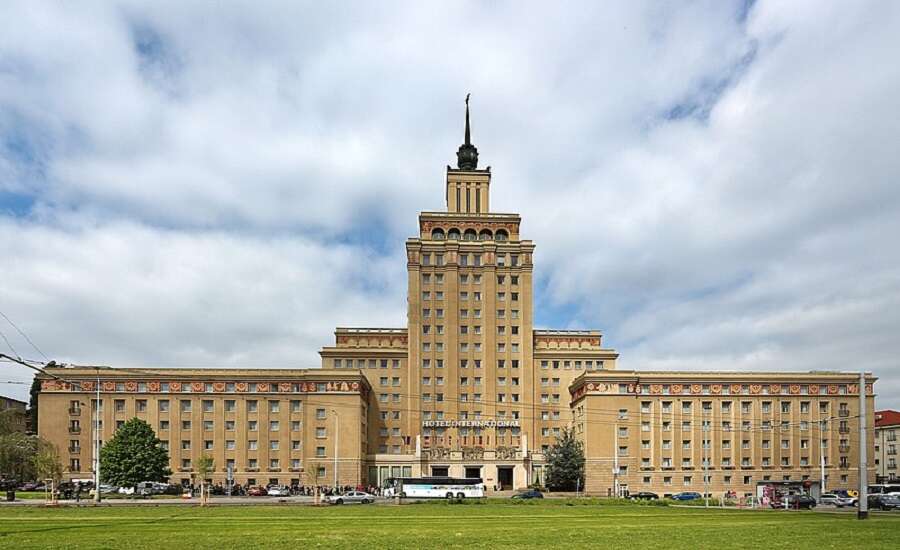
Photo by User:simon04 on Wikipedia
Did you know? Other similar skyscrapers were constructed in Kiev, Riga, Prague and Bucharest. The largest is the Palace of Science and Culture in Warsaw, built by Lev Rudnev between 1952 and 1955 as a gift to Poland from the Soviet Union, and nicknamed ‘Stalin’s Souvenir’. At 237 metres, it is the tallest building in Poland and contains libraries, theatres, cinemas, museums, research institutes, and government departments.
The interiors of the Seven Sisters contain gleaming marble floors, carved stone, columns, precious wood panelling, high ceilings, stained glass, and even chandeliers. The architects noted that in skyscrapers in the USA, many of the rooms were dark and overlooked deep inner courtyards, and they thus designed the Seven Sisters so that all rooms would have plenty of natural light.
Did you know? Some interior decorative elements were in fact made from papier mache, to reduce the cost and weight of construction materials.
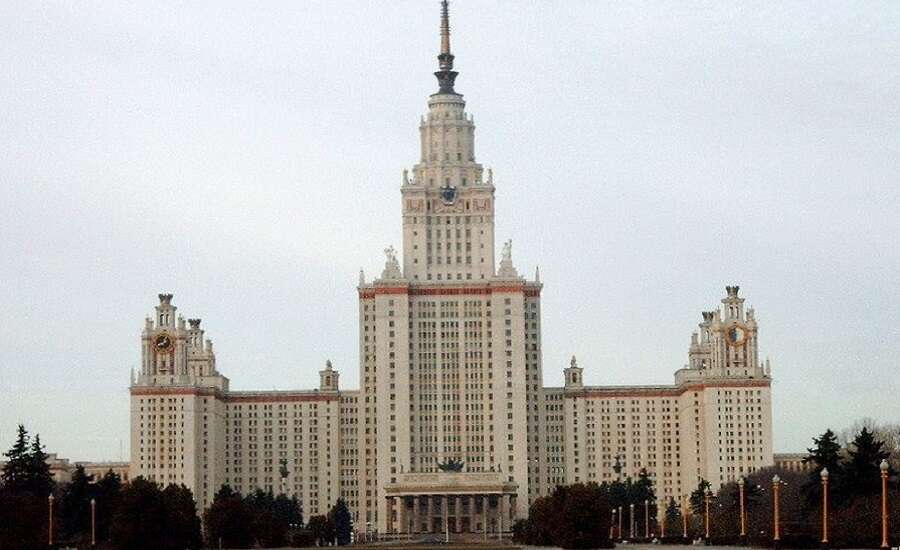
Photo by Schoschi (Georg Dembowski) on Wikipedia
The largest of the Seven Sisters is the main building of Moscow State University on Sparrow Hills, designed by Lev Rudnev and constructed between 1949 and 1953 by thousands of Gulag labourers. It was the tallest building in Europe until 1990 and remains today the largest educational building in the world! Four sprawling wings extend from a central tower reaching 240 metres into the sky, and each wing is crowned by smaller towers fronted by enormous clocks. In the student dormitories in the wings alone, there are 6,000 rooms.
Did you know? 40,000 tons of steel and 175 million bricks were used to construct the MGU main building, and the interior lighting network is over 450km long.
The MGU main building was constructed with granite from Ukraine and marble from Georgia and Uzbekistan. It was proposed to place a statue of Stalin atop the building, though Stalin instead ordered for a spire to crown the building. Huge statues of workers and farmers stand at the 27th floor, and there are bas-reliefs of workers and students. The main building still retains its gorgeous original interiors.
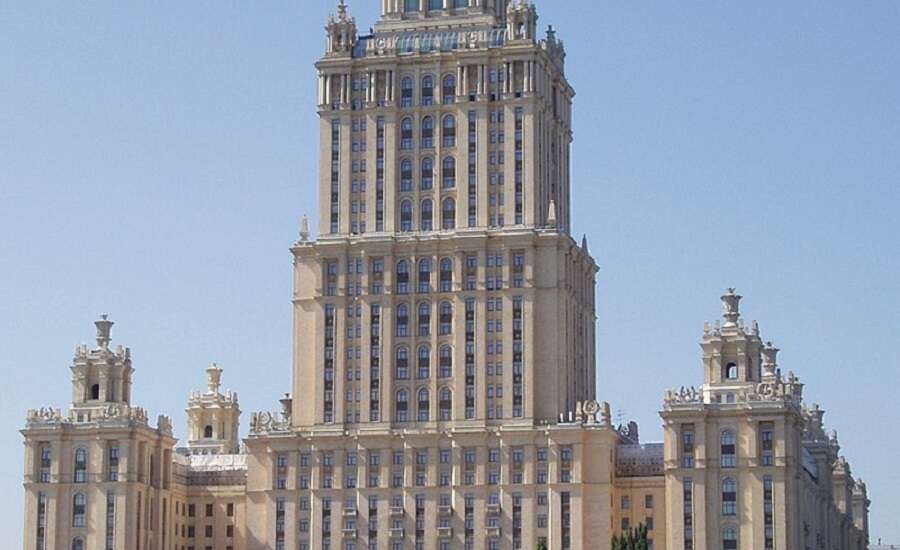
Photo on Wikipedia
Hotel Ukraina was built by Arkady Mordvinov and Vyacheslav Oltarzhevsky between 1953 and 1957. The U-shaped building is faced with white ceramic blocks, limestone and granite. Four towers stand atop each of the two wings, stylised with Soviet symbols and wheat sheaves. Upon opening, the Ukraina was the tallest hotel in Europe, and received its name in honour of the 300th anniversary of the unification of Russia and Ukraine, celebrated in 1954. A prestigious hotel, it was intended as the residence for foreigners visiting the USSR. 1,200 paintings by Soviet artists decorated the inside, and a winter garden with a fountain was constructed on the 2nd floor.
Today, the building houses a hotel and residential apartments; the hotel occupies the main building, and the apartments the two wings. The luxurious interiors of the public spaces have been preserved since the 1950s, including the paintings and sculptures. It is possible to visit a viewing platform on the 33rd floor for a panorama of the historical centre of Moscow (access is free for hotel guests, and paid for non-guests).
Did you know? The hotel counts among its former guests Robert de Niro, Ralph Fiennes, and Cristiano Ronaldo.
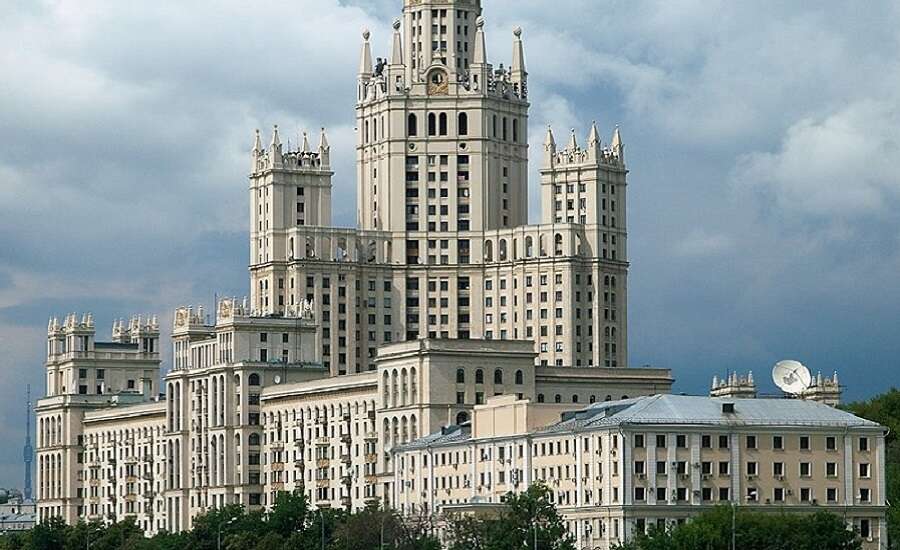
Photo by NVO on Wikipedia
The Kotelnicheskaya Embankment Building was built between 1947 and 1952 by Dmitry Chechulin, the chief architect of Moscow, at the confluence of the Moskva and Yauza Rivers. Three wings are attached to a hexagonal central tower, two of which extend into large apartment blocks. Ornate arches, columns, turrets, and spiked metal ornaments decorate the central and side towers. In its 540 apartments lived celebrities, important scientists and members of the Soviet government, and it housed a post office, restaurant, football pitch, cinema, and even a massage parlour.
Did you know? As the skyscraper was constructed by Gulag labour, engraved messages from prisoners were discovered by residents there!
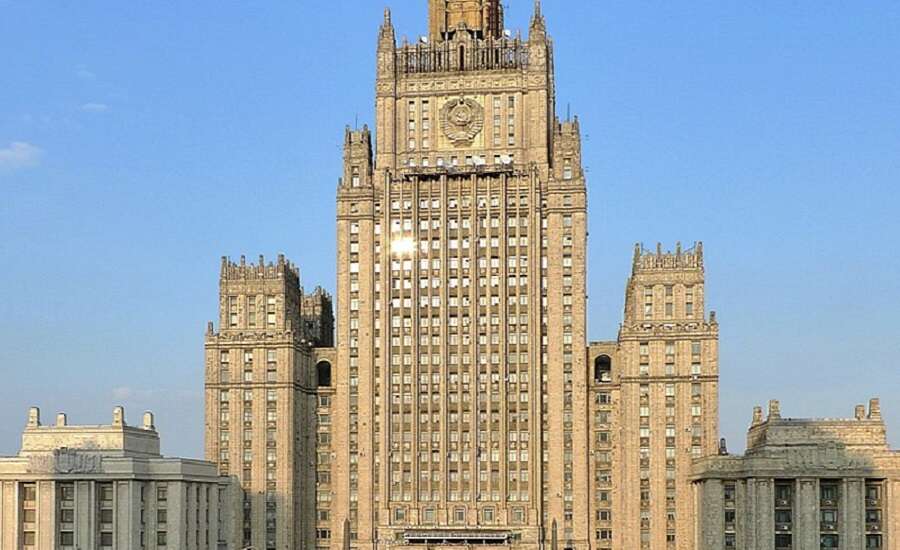
Photo by Ministry_of_Foreign_Affairs_Russia.jpg on Wikipedia
The Russian Ministry of Foreign Affairs was constructed between 1948 and 1953 by Vladimir Gelfreykh and Adolf Minkus. It is made of red and grey granite, limestone and ceramic blocks, and has many features of English Gothic architecture. Two wings extend from the central tower, each crowned with two square towers. The interior was decorated in the style of Soviet Art Deco, with marble, granite, and stained glass. Interestingly, an enormous crest of the USSR remains on the front of the building – as a monument of architectural heritage, the decision was taken not to remove it.
Did you know? The Ministry of Foreign Affairs was the only one of the Seven Sisters not to be crowned with a 5-pointed star, as its spire was too weak.
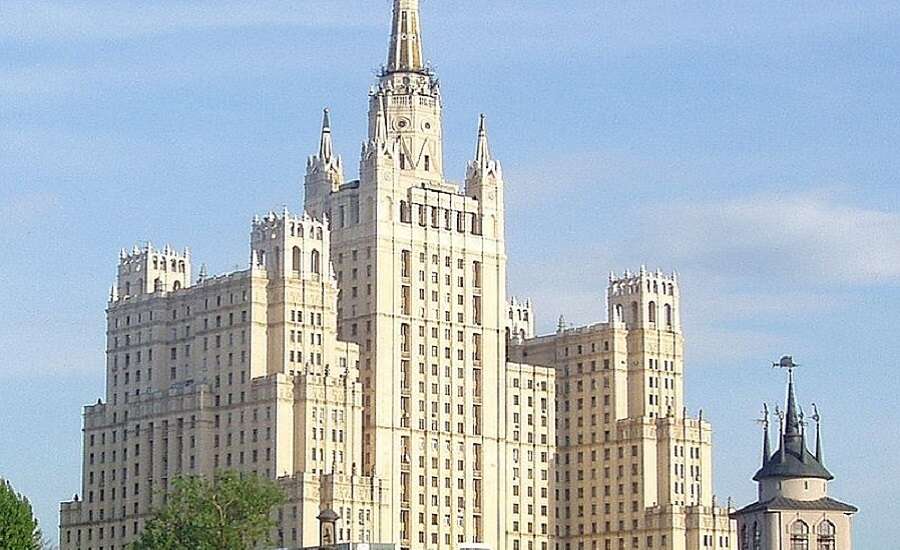
Photo by Dmitry Rozhkov on Wikipedia
The Kudrinskaya Square Building was constructed by Mikhail Posokhin and Ashot Mndoyants between 1948 and 1954. As with the skyscraper on Kotelnicheskaya, it was built for Moscow’s elite and housed over 450 luxury apartments, a cinema, underground car park, ice cream parlour, and Moscow’s largest grocery store. It was richly decorated both inside and out: the exterior is adorned with carved rosettes, cornices, turrets, statues, ornate towers on each corner, and an elegant spire; the interior with chandeliers, stained glass, Greek columns and patterned marble floors. Apartments in the building today are extremely expensive real estate.
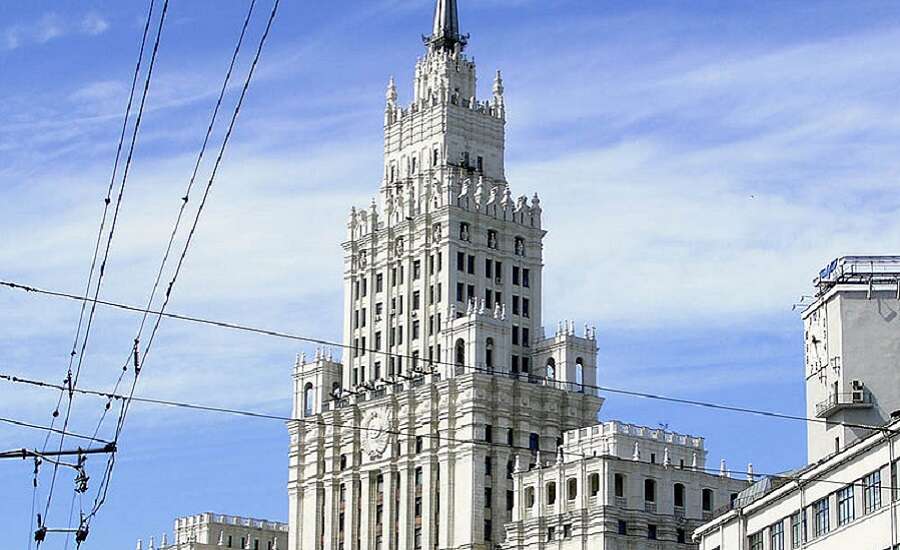
Photo by NVO on Wikipedia
The Red Gates Administrative Building was constructed between 1948 and 1951 by Alexei Dushin. In the U-shaped building, offices are located in the central tower and apartments in the wings, a setup which has remained since the 1950s. The façade is made from limestone embellished with intricate layers of cornices at the top of each tier and a grand entrance made from red granite. Interestingly, there is an entrance to the Krasnye Vorota (Red Gates) metro station right inside the building.
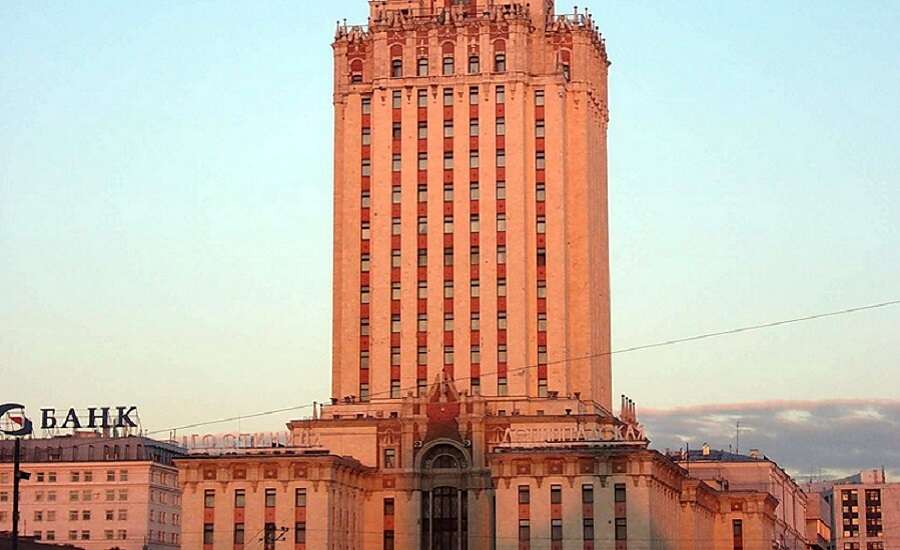
Photo on Wikipedia
The Leningradskaya Hotel was constructed between 1949 and 1954 by Leonid Polyakov and Alexander Boretsky. The architecture and design of this skyscraper is considered to have the most Russian elements compared to its sisters, in particular its tented porch entrance. Palatial public areas were decorated with statues, bronze chandeliers, painted ceilings, murals and stained glass, and there is even a ballroom. Although the excessive luxury of the hotel was shamed in the Khrushchev era, the décor has thankfully been preserved.
Did you know? In the stairwell between the 2nd and 7th floors hangs a chandelier, suspended by a 15.5 metres long bronze garland – once the longest lighting fixture in the world!
Visit one of our Moscow tours pages
Join us on Facebook
We invite you to become a fan of our company on Facebook and read Russian news and travel stories. To become a fan, click here.
Join our own Russian Travel, Culture and Literature Club on Facebook. The club was created to be a place for everyone with an interest in Russia to get to know each other and share experiences, stories, pictures and advice. To join our club, please follow this link.